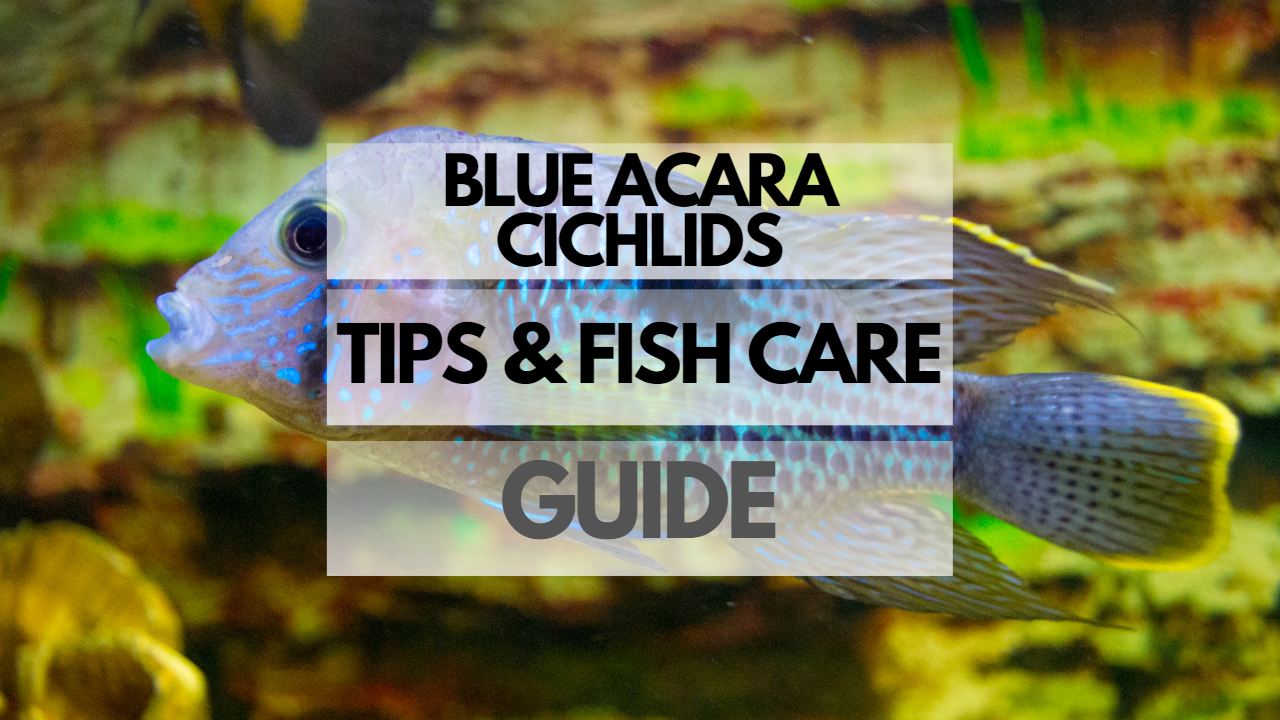Blue Acara Cichlids are beautiful and personable fish that can make a great addition to your aquarium. In this guide, we’ll provide you with all the information you need to know about caring for these colorful and social pets.
Quick Reference Table: Blue Acara Cichlid Facts
| Fact | Details |
|---|---|
| Scientific Name | Andinoacara pulcher |
| Ease of Care | Moderate |
| Lifespan | 8-10 years |
| Color Variations | Blue, green, and gold |
| Size | 6-7 inches |
| Tank Size | Minimum 30 gallons |
| Water Temperature | 75-82°F (24-28°C) |
| Food | Omnivorous; pellets, flakes, live and frozen foods |
| Can Survive in Bowls | No |
| Requires Filter | Yes |
| Requires Heater | Yes |
How Are Blue Acara Cichlids as Pets?
Blue Acara Cichlids are beautiful fish that can add a splash of color and personality to your aquarium. They are generally peaceful and can get along well with other tank mates, making them a popular choice for community aquariums. With proper care and attention, these fish can thrive and become a beloved part of your aquatic family.
Are Blue Acara Cichlids Easy to Care For?
Blue Acara Cichlids have moderate care requirements, which means they may not be suitable for beginners. However, with some experience and dedication, most aquarists can successfully care for these fish and enjoy their vibrant colors and social nature.
Pros and Cons of Blue Acara Cichlids
| Pros | Cons |
|---|---|
| Beautiful colors | Moderate care requirements |
| Generally peaceful temperament | Can be territorial during breeding |
| Suitable for community tanks | Needs a larger tank (minimum 30 gallons) |
| Long lifespan | Not suitable for small bowls or nano tanks |
How Much Do Blue Acara Cichlids Cost?
The price of a Blue Acara Cichlid can range from $8 to $20, depending on factors like size, color, and quality. The initial setup costs for a suitable tank, filter, heater, decorations, and substrate can range from $200 to $500. Ongoing expenses include food, water treatments, and occasional replacement of equipment.
Blue Acara Cichlid Lifespan
With proper care, Blue Acara Cichlids have an average life expectancy of 8-10 years. To keep your fish healthy and happy, it’s essential to provide a suitable environment, a balanced diet, and regular maintenance. Keep in mind that owning Blue Acara Cichlids requires a long-term commitment to their care and well-being.
Blue Acara Cichlid Care Guide
Blue Acara Cichlid Habitat and Tank Setup
“`html
Appropriate Blue Acara Cichlid Tank Size and Type
Blue Acara Cichlids require a minimum tank size of 30 gallons, with larger tanks being even better. A long, rectangular tank with a lid is ideal to provide enough swimming space and prevent escapes.
Blue Acara Cichlid Water Temperature and Quality
Maintain a water temperature of 75-82°F (24-28°C) and a pH level of 6.5-7.5. Regularly test the water for ammonia, nitrite, and nitrate levels to ensure a healthy environment for your fish.
Filtration and Aeration Requirements
A high-quality filter is essential for maintaining water quality. Blue Acara Cichlids prefer moderate water flow, so make sure the filter output isn’t too strong. Additionally, an air stone or sponge filter can help with aeration and oxygenation.
Lighting Requirements
Blue Acara Cichlids do not have specific lighting requirements, but a standard aquarium light on a timer set to mimic a natural day-night cycle is recommended.
Plants for Blue Acara Cichlids
Live plants like Anubias, Java Fern, and Vallisneria can provide hiding spots and improve water quality. However, these fish may uproot plants, so it’s a good idea to secure them with plant weights or use artificial plants.
Substrate, Hideouts, and Decorations
Use sand or fine gravel as a substrate. Provide plenty of hiding spots and decorations, such as rocks, driftwood, and caves, for your Blue Acara Cichlids to explore and claim as territories.
Aquarium Cleaning and Maintenance
Perform regular water changes of 25-30% every two weeks, and clean the substrate with a gravel vacuum to remove waste. Ensure that the filter is clean and functioning properly, replacing filter media as needed.
Blue Acara Cichlid Food and Diet
What Do Blue Acara Cichlids Eat?
Blue Acara Cichlids are omnivorous and will eat a variety of foods. Provide a balanced diet with high-quality pellets or flakes, supplemented with live or frozen foods like brine shrimp, bloodworms, and daphnia.
Feeding Frequency and Schedule
Feed your Blue Acara Cichlids two to three times per day, offering only as much food as they can consume within a few minutes. Remove any uneaten food to prevent water quality issues.
Blue Acara Cichlid Treats
Occasionally offer treats like blanched vegetables (such as zucchini or spinach) and fruit (like apple or pear) to provide variety and additional nutrients to their diet.
Health and Wellness
Common Health Issues
Blue Acara Cichlids are generally hardy fish, but they can still experience some common health issues. These include:
- Ich (White Spot Disease): A parasitic infection that causes small white spots on the fish’s body.
- Fin Rot: A bacterial infection that leads to the deterioration of the fish’s fins.
- Swim Bladder Disease: A disorder that affects the fish’s buoyancy, causing it to have difficulty swimming.
By maintaining proper water quality and a stress-free environment, you can minimize the risk of these health issues.
Signs of a Healthy Blue Acara Cichlid
It’s essential to know the difference between a healthy Blue Acara Cichlid and a sick one. Below is a table comparing the two:
| Healthy Blue Acara Cichlid | Sick Blue Acara Cichlid |
|---|---|
| Clear eyes | Cloudy or swollen eyes |
| Active and alert | Sluggish or lethargic |
| Bright and vibrant coloration | Faded or dull coloration |
| Intact, smooth fins | Torn or frayed fins |
| Regular appetite | Loss of appetite |
Blue Acara Cichlid Breeding
Blue Acara Cichlids are relatively easy to breed in captivity. They form monogamous pairs, and once they pair up, they’ll start preparing a spawning site. The female will lay eggs on a flat surface, and the male will fertilize them. Both parents will guard and care for the eggs and fry until they’re independent.
Blue Acara Cichlid Tank Mates: Can They Live with Other Fish?
Blue Acara Cichlids are more peaceful than many other cichlids, making them suitable for community tanks. However, they should be kept with other fish of similar size and temperament. Some compatible tank mates include tetras, catfish, and other peaceful cichlids.
Blue Acara Cichlid Varieties and Species
There are several varieties and closely related species of Blue Acara Cichlids. Some of these include the Electric Blue Acara, Green Terror, and the Balloon Blue Acara. Each of these has unique color patterns and slightly different care requirements.
Additional Resources
Here’s a list of resources to help you learn more about Blue Acara Cichlids:
FAQ for Blue Acara Cichlid Care
- Q: Can Blue Acara Cichlids live with other fish?
- A: Yes, they can. They are peaceful cichlids and can live with other fish of similar size and temperament.
- Q: How long do Blue Acara Cichlids live?
- A: They typically live for 8-10 years with proper care.
- Q: How often should I clean my Blue Acara Cichlid’s tank?
- A: Perform a partial water change of 25-30% every two weeks to maintain water quality.
- Q: Can Blue AcaraCichlids change color?
- A: Yes, they can change color depending on their mood, health, and breeding status.
- Q: Are Blue Acara Cichlids good for beginners?
- A: Yes, they are hardy fish and can be a good choice for beginner aquarists.
- Q: Do Blue Acara Cichlids need a filter?
- A: Yes, a filter is essential to maintain proper water quality and remove waste.
- Q: Do Blue Acara Cichlids need a heater?
- A: Yes, they require a heater to maintain a consistent water temperature of 72-82°F (22-28°C).
- Q: Can Blue Acara Cichlids survive in bowls?
- A: No, they require a spacious tank with proper filtration and heating. A minimum tank size of 30 gallons is recommended.
- Q: Do Blue Acara Cichlids sleep?
- A: Yes, they have a period of rest during the night when they become less active.
- Q: Can Blue Acara Cichlids live with snails?
- A: Yes, they can coexist with snails, as long as the snails are not too small and can’t be eaten by the cichlids.

